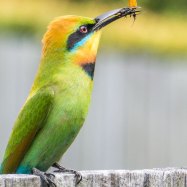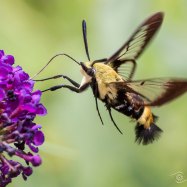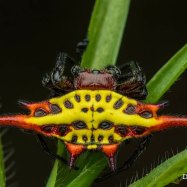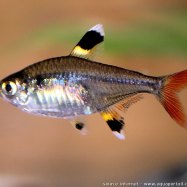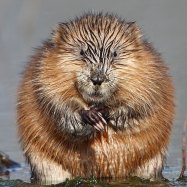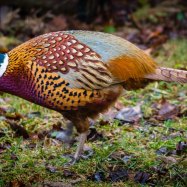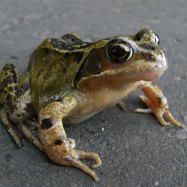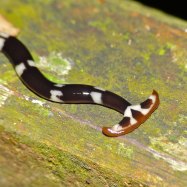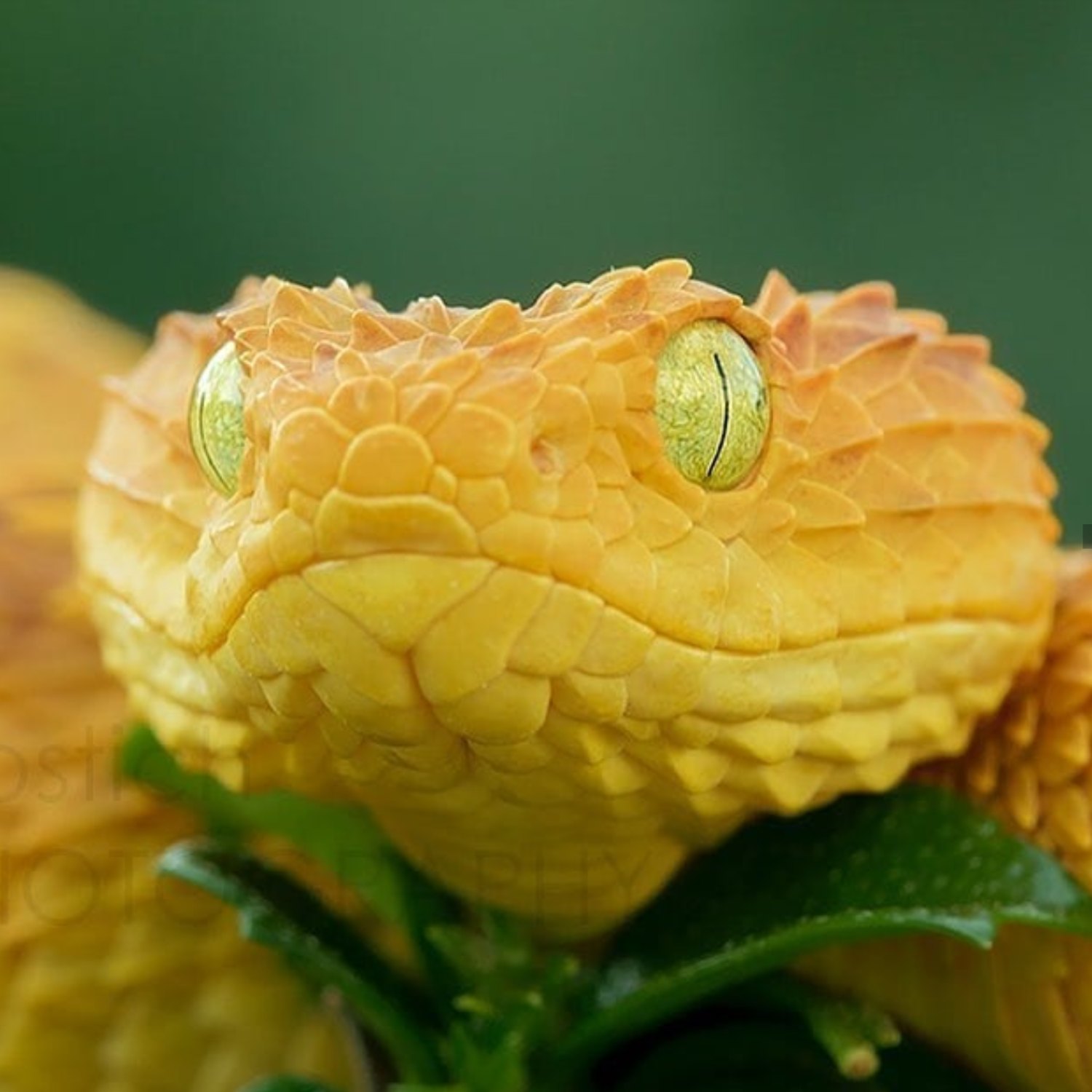
Eyelash Viper
Ranges from 2 to 3 feet
The Eyelash Viper, found in trees and shrubs, is a venomous snake with distinct patterns and long eyelashes above their eyes. These short and stout vipers, from the Viperidae family, can range from 2-3 feet in length. They are commonly found in Central and South America and are known for their unique triangular-shaped head. Be sure to admire these beautiful yet dangerous creatures from a distance! #AnimalFact #EyelashViper #SnakeSafety
Animal Details Summary:
Common Name: Eyelash Viper
Kingdom: Animalia
Habitat: Tropical rainforests
The Striking Beauty and Deadly Nature of the Eyelash Viper
The world of reptiles is filled with a diverse and fascinating array of creatures, ranging from giant marine crocodiles to tiny lizards that can fit in the palm of your hand. One of the most captivating members of this group is the eyelash viper, also known by its scientific name as Bothriechis schlegelii. This species has captured the attention of many due to its unique characteristics and stunning appearance. In this article, we will dive into the details of this mesmerizing animal, from its physical features to its habitat, feeding habits, and more Eyelash Viper.An Introduction to the Eyelash Viper
The eyelash viper is a venomous snake that belongs to the family Viperidae, which is known for their venomous fangs and triangular-shaped heads. This species is native to the tropical rainforests of Central America and northern South America and is commonly found in countries like Costa Rica, Nicaragua, Panama, and Colombia. Its name comes from the distinctive scales above its eyes, which resemble eyelashes, giving the snake an alluring and charming look.Despite its lethal nature, the eyelash viper is a relatively small snake, with a length ranging from 2 to 3 feet. Its short and stout body is covered in brightly colored scales, and its colors can vary from green, yellow, red, to brown, with intricate patterns that make each individual unique. This snake is also known for its thermoregulation, which means it can change its body temperature based on its surroundings. As a result, it is considered a cold-blooded animal, meaning it relies on external sources to regulate its body temperature.
The Habitat and Geographic Distribution of the Eyelash Viper
As mentioned earlier, the eyelash viper is predominantly found in the tropical rainforests of Central and South America. These regions provide a perfect habitat for this species, as they are warm, humid, and have an abundance of trees and shrubs for the snake to live and hunt in Earwig. The lush vegetation also provides an ideal camouflage for the snake, making it difficult for predators to spot them.Within these rainforests, the eyelash viper can be found in a variety of locations, from the forest floor to the treetops. This versatile species is known for its exceptional climbing abilities, and it can often be found coiled up on branches or hanging from vines, waiting to strike. Their agile and quick movements allow them to navigate through the dense vegetation with ease, making them efficient hunters in their natural habitat.
The Feeding Habits of the Eyelash Viper
Like all vipers, the eyelash viper is a carnivorous species, meaning it primarily feeds on other animals. This snake is an ambush predator, relying on its excellent camouflage and quick strikes to catch its prey. Its diet consists mainly of small mammals, birds, lizards, and amphibians. The venom injected through its fangs is powerful enough to immobilize its prey, allowing the snake to consume it at its leisure.One of the most intriguing aspects of the eyelash viper's feeding habits is its ability to control the amount of venom it injects into its prey. This allows the snake to conserve its venom for future hunts and also adjust the potency of its venom based on the size and type of prey. This evolutionary adaptation showcases the intelligence and adaptability of this species, making it a formidable predator in its ecosystem.
The Physical Characteristics of the Eyelash Viper
The most striking feature of the eyelash viper is its coloration, which varies from individual to individual. The color and pattern of this snake are not only aesthetically pleasing but also serve as a form of protection. The brightly colored scales serve as a warning to potential predators, signaling that the snake is venomous and should be avoided. In fact, many species of birds and mammals have a natural aversion to bright colors, which further deters them from approaching the snake.Apart from its coloration, the eyelash viper has a unique triangular-shaped head, which is characteristic of all vipers. This shape allows them to open their mouths wide and accommodate their long fangs, which can reach up to an inch in length. Its body shape is short and stout, with a thick midsection that houses its organs and allows it to store large amounts of venom. Its eyes are also noteworthy, as they have vertical pupils that give the snake a menacing appearance.
The Importance of the Eyelash Viper in its Ecosystem
As with all animals, the eyelash viper plays an essential role in its ecosystem. It helps to keep the balance of prey and predator populations in check, preventing the overpopulation of any specific species. Its venom also plays a crucial role in maintaining the biodiversity of the rainforest. The venom breaks down the carcass of its prey, aiding in nutrient cycling and providing fertilizer for plants to grow.Moreover, the eyelash viper serves as an indicator of the overall health of the rainforest. As a top predator, any changes in its population can reflect larger environmental issues within its habitat. For example, a decline in the number of eyelash vipers could indicate a loss of biodiversity or an imbalance in the food chain, emphasizing the importance of conserving this species and its habitat.
Threats and Conservation Efforts
Despite its crucial role in its ecosystem, the eyelash viper faces various threats to its survival. One of the main threats is habitat loss due to deforestation, which results in a decrease in suitable hunting grounds and hiding places. This loss of habitat also exposes the snake to human activities, such as farming and logging, which can lead to direct harm to the species.The pet trade is another major threat to the eyelash viper, as it is a popular snake among reptile enthusiasts. Although there are strict regulations in place for international trade of this species, illegal poaching and smuggling still occur, further endangering their population.
Fortunately, several conservation efforts are in place to protect the eyelash viper and its habitat. In Costa Rica, where the majority of these snakes are found, there are several national parks and reserves that provide protection to the species. These protected areas also serve as a hub for research and education, raising awareness about the importance of preserving this species.
In Conclusion
The eyelash viper is a mesmerizing and intriguing member of the reptile family. Its stunning coloration, unique physical features, and important role in its ecosystem make it a species worth learning about and conserving. As we continue to discover more about this snake and its habitat, it is essential to ensure that we take measures to protect them and other species that call the tropical rainforest their home. By preserving the diversity of species in this fragile environment, we can create a sustainable future for all life on our planet.

Eyelash Viper
Animal Details Eyelash Viper - Scientific Name: Bothriechis schlegelii
- Category: Animals E
- Scientific Name: Bothriechis schlegelii
- Common Name: Eyelash Viper
- Kingdom: Animalia
- Phylum: Chordata
- Class: Reptilia
- Order: Squamata
- Family: Viperidae
- Habitat: Tropical rainforests
- Feeding Method: Carnivorous
- Geographical Distribution: Central America and northern South America
- Country of Origin: Costa Rica
- Location: Trees and shrubs
- Animal Coloration: Brightly colored (green, yellow, red, or brown) with patterned scales
- Body Shape: Short and stout with a triangular-shaped head
- Length: Ranges from 2 to 3 feet
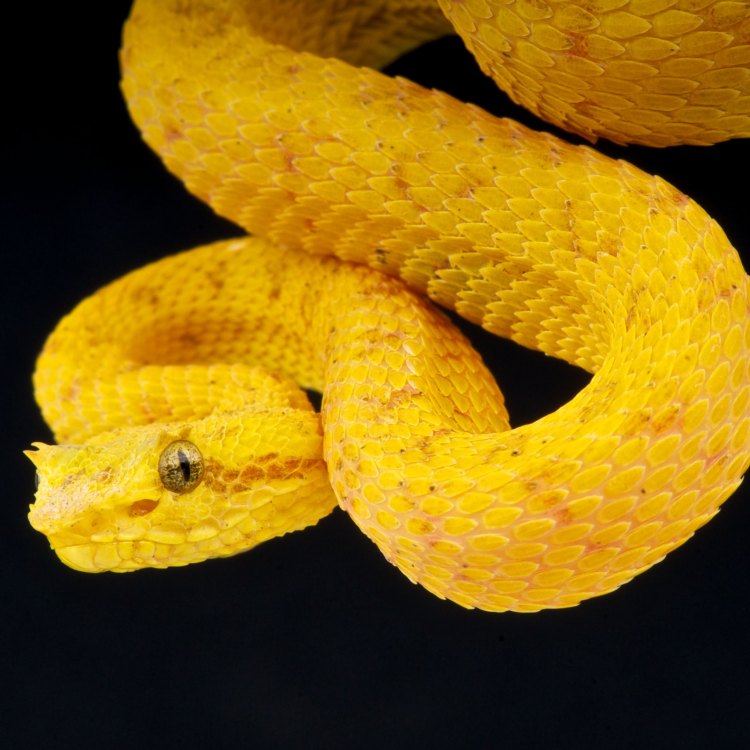
Eyelash Viper
- Adult Size: Medium-sized
- Average Lifespan: 10 to 20 years
- Reproduction: Sexual
- Reproductive Behavior: Viviparous (gives birth to live young)
- Sound or Call: Hisses when threatened
- Migration Pattern: Non-migratory
- Social Groups: Solitary
- Behavior: Nocturnal and arboreal
- Threats: Habitat loss and illegal pet trade
- Conservation Status: Least Concern
- Impact on Ecosystem: Helps regulate prey populations
- Human Use: None
- Distinctive Features: Eyelash-like scales above the eyes
- Interesting Facts: The bright coloration of the eyelash viper serves as a warning to potential predators
- Predator: Birds of prey and larger snakes

Bothriechis schlegelii
The Enigmatic and Colorful Eyelash Viper
Deep within the lush and diverse rainforests of Central and South America, a mysterious and colorful creature resides. Its striking appearance and unique features have earned it the moniker of the "eyelash viper," also known as the "eyelash palm pit viper." Its scientific name, Bothriechis schlegelii, is derived from the Greek words "bothrios," meaning "pit," and "echis," meaning "viper." This small but fascinating snake has captured the attention of biologists, herpetologists, and nature enthusiasts alike PeaceOfAnimals.Com. Join me on an adventure to discover the wondrous world of the eyelash viper.Size and Lifespan
The eyelash viper is considered a medium-sized snake, with adults typically reaching lengths of two to three feet. However, some individuals have been reported as long as four feet in length. These snakes have a slender and heavily keeled body, giving them a rough and textured appearance. They also possess a distinctively triangular head, with two small horns above their eyes, adding to their mysterious and otherworldly appearance.The average lifespan of the eyelash viper is between 10 to 20 years. However, some individuals have been reported to live up to 25 years in captivity. Their longevity is affected by various factors, including habitat conditions, availability of food, and human interference.
Reproduction and Behavior
The eyelash viper is a sexual species, meaning it requires both a male and a female for reproduction Eurasian Sparrowhawk. These snakes are viviparous, meaning they give birth to live young, rather than laying eggs like most snakes. After a successful mating, the female will carry the fertilized eggs within her body until they hatch, typically within three to six months. She will then give birth to between six to twelve offspring, each measuring around six inches in length.These snakes are known to be solitary creatures, preferring to stay alone and hunt at night. They are also arboreal, meaning they spend most of their time in trees, using their prehensile tail to grip onto branches. Their nocturnal behavior serves as a defense mechanism against potential predators, as they can blend into the darkness and remain undetected.
Distinctive Features
One of the most striking features of the eyelash viper is its vibrant and colorful appearance. These snakes come in a variety of colors, including green, yellow, orange, and red. Their coloration serves as a warning to potential predators, as they are venomous. However, their bright and beautiful hues also make them popular in the exotic pet trade, which poses a significant threat to their population.Another unique feature of the eyelash viper is the presence of tiny, bristly scales above its eyes, resembling eyelashes. These scales, known as supraocular scales, are believed to help protect the snake's eyes from falling debris and sunlight.
Sound and Predators
Unlike some of its more famous relatives, such as the rattlesnake, the eyelash viper does not have a rattle to warn potential predators. Instead, when threatened, it will coil its body and produce a loud hissing sound by forcing air through its mouth. This warning is usually accompanied by a striking defensive posture, displaying its triangular head and exposing its fangs, ready to defend itself if necessary.The main predators of the eyelash viper are birds of prey and larger snakes. Their cryptic coloration allows them to blend seamlessly into their surroundings, making them challenging to spot. However, their hissing sound and defensive behavior can also draw attention to them and alert their predators.
Threats and Conservation Status
The eyelash viper is currently listed as "Least Concern" on the International Union for Conservation of Nature (IUCN) Red List. However, this does not mean that the species is not facing any threats. The most significant threat to this species is habitat loss due to deforestation for agricultural and urbanization purposes. These snakes have adapted to thrive in their natural habitat of dense rainforests, and any disturbance can have a significant impact on their population.Additionally, the illegal pet trade poses a severe threat to the eyelash viper. Due to their unique and stunning appearance, they are highly sought after in the exotic pet market. Their capture and transportation can also cause stress and harm to the snakes, reducing their chances of survival.
Role in the Ecosystem
Like all species, the eyelash viper plays a crucial role in maintaining the balance of its ecosystem. As an ambush predator, it feeds on a variety of small mammals, birds, and amphibians. By regulating the population of these prey species, the eyelash viper helps to ensure that the ecosystem remains in equilibrium.Their venom also plays a vital role in the ecosystem, as it is used to subdue and kill their prey. The venom of the eyelash viper is hemotoxic, meaning it attacks the victim's blood cells, causing tissue damage and, in some cases, death. However, it is not considered life-threatening to humans, unless left untreated.
Human Use
Unlike other venomous snake species, the eyelash viper does not have any medicinal or commercial use for humans. Its venom does not possess any significant therapeutic properties, and it is not used for antivenom production. This is mainly due to the fact that venom extraction from these small and delicate snakes is challenging and not economically feasible.Final Thoughts
The enigmatic and colorful eyelash viper is a fascinating and elusive species that deserves our admiration and protection. Its striking appearance and unique features make it an important part of the biodiversity in its natural habitat. However, with habitat loss and the illegal pet trade posing significant threats to its survival, it is crucial that we take action to protect this species and preserve its role in our delicate ecosystem.Whether admired from a distance or observed in captivity, the eyelash viper is a remarkable creature that continues to captivate and intrigue us with its beauty and mystery. So, the next time you come across this little gem of the rainforest, take a moment to appreciate its unique features and the role it plays in maintaining the balance of its habitat.
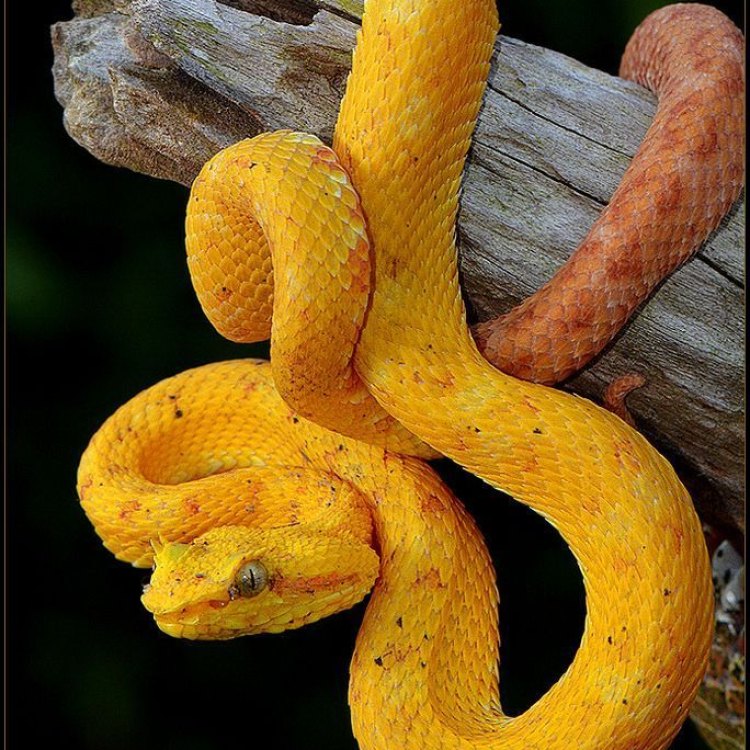
The Striking Beauty and Deadly Nature of the Eyelash Viper
Disclaimer: The content provided is for informational purposes only. We cannot guarantee the accuracy of the information on this page 100%. All information provided here may change without prior notice.

